Menu
Join Our Email List
- Receive our monthly newsletter.
- Stay up to date on Amazon policies.
- Get tips to grow your business.

Reviews are vital for any business that sells on Amazon. They impact everything from your product ranking to inventory planning and advertising strategy. Recent and relevant reviews provide important insights for online shoppers, who often turn to these ratings to inform purchase decisions.
Getting Amazon reviews can be challenging for sellers and brands. It's also important to understand Amazon's review guidelines to avoid putting your account at risk. In this guide, we'll discuss how to get Amazon reviews, how reviews can improve your business, and how to stay compliant with Amazon policies when requesting reviews.
Ready to start getting Amazon reviews?
FeedbackFive by eComEngine automates review requests that are compliant with Amazon's policies. Getting started only takes a couple of minutes. Try it free for 14 days!
TRY FEEDBACKFIVE
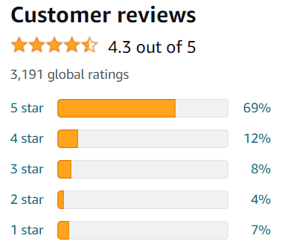 An Amazon review is a public rating of the buyer's satisfaction with a particular product. Based on a five-star scale, reviews can be provided in the form of a simple star rating, written explanation, or video. Since the company's founding, Amazon has amassed millions of high-quality reviews from shoppers across the globe, making it the most prolific source of consumer-generated product information in the world.
An Amazon review is a public rating of the buyer's satisfaction with a particular product. Based on a five-star scale, reviews can be provided in the form of a simple star rating, written explanation, or video. Since the company's founding, Amazon has amassed millions of high-quality reviews from shoppers across the globe, making it the most prolific source of consumer-generated product information in the world.
Buyers can either write a full review or simply score a product on a five-star scale without leaving comments—this is called a rating. Ratings are included in the total number of reviews on an Amazon listing and factor into the overall star rating but do not include text or other content. The total number of Amazon seller reviews and ratings appear as "global ratings" on the listing.
Amazon does not use a simple average to calculate the overall star rating. How recent a review is and whether the item was purchased on Amazon or somewhere else affect the average. Ratings from buyers who did not make a verified purchase on Amazon won't be considered in a product's overall rating unless the buyer provides additional details in a written review, image, or video of the product. Amazon's system also looks for signs of untrustworthy reviews.
Reviews are different than seller feedback. Many people use the terms "feedback" and "review" interchangeably, but, in the strictest sense, an Amazon review should only reflect the buyer's experience with the product itself - not the seller. Verified Amazon reviews (also referred to as Amazon Verified Purchase reviews) are reviews provided by customers who purchased a product directly from Amazon. Although anyone can leave Amazon product reviews, these verified reviews are given more weight in Amazon's search algorithm and have a more direct impact on your product ranking.
Amazon customer reviews are an important building block for the continued success of your product. Customers rely on reviews to inform purchase decisions. Here are some top reasons you want to get reviews on Amazon:
Quality reviews help boost product search rankings, which allows more buyers to discover your product, increasing your sales potential. Buyers are more likely to purchase a product that has good reviews, so getting your first few reviews soon after a product launch is crucial.
Customer reviews can provide useful data for improving your products. Learn what's working and what needs to be improved straight from your customers. Look for comments and suggestions that appear most frequently in your reviews, then consider how you might be able to implement them.
Want to differentiate your products or add a new product line? Your Amazon product reviews provide a wealth of information about what buyers want, directly from your target audience. Keeping tabs on this data can help you identify the types of opportunities that could take your business to the next level.
Customer reviews can help you predict how well a product will sell. If you're seeing a steady stream of great reviews, it's a sign that your product is a hit. Plan accordingly when restocking to avoid stockouts. If you notice a drop in your average review ratings, it's time to take a closer look at your product to understand what's going wrong.
As an Amazon seller, one of your main goals is ensuring buyers are happy with your products. Reviews allow you to find out exactly what customers think of your items. These reactions provide invaluable information and may help you identify new use cases.
Amazon customers trust reviews to make purchasing decisions. Over 90% of shoppers read online ratings before making a purchase. In a digital marketplace, buyers can't physically evaluate items. Product reviews provide vital "word of mouth" style insight for Amazon shoppers from other customers.
Perhaps the biggest reason why you want to get Amazon reviews is that the Amazon algorithm determines where products are shown in search results. Ranking on the first page of Amazon's search results significantly increases your chances of making a sale. Getting reviews regularly and having a history of positive Amazon reviews both factor into the algorithm.
Amazon reviews provide social proof to help you establish and boost your brand. Building your brand identity on Amazon can drastically improve the discoverability of your products. The Amazon Brand Registry program offers many exclusive benefits for brand-registered sellers, including the ability to respond to negative reviews.

A superior rating signals customer satisfaction, top-tier product quality, and a favorable brand image. Consequently, businesses boasting high review ratings are often more enticing to prospective buyers.Benchmark Guide for Amazon Private Label

Learn how to get reviews on Amazon while staying compliant with guidelines.
Amazon allows sellers to send proactive permitted messages to request reviews and/or seller feedback. There are a few ways to do this: manually sending requests using the Request a Review button in Seller Central or automating your requests with software included in the Selling Partner Appstore. The majority of sellers use third-party software like FeedbackFive to automate the process of requesting reviews with the Amazon API.
All communication with buyers must be sent within 30 days of order completion, include the order ID, and be translated into the buyer's language of preference.
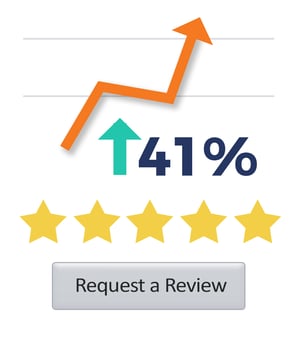
Amazon Request a Review Message: The Request a Review message is sent directly from Amazon to the buyer on your behalf upon your request. It cannot be customized, but it is automatically translated into the buyer's preferred language. You can send manual requests from the Order Details page in Seller Central or use software to automate this request. Sellers have been getting great results with this messaging option. In a random sampling of FeedbackFive customers, we saw a 41% increase in the daily average review rate after implementing this feature.
Software for Amazon Sellers: You can find tools that connect with the Amazon API, like our own FeedbackFive, in the Selling Partner Appstore, formerly the Seller Central Partner Network. Our software allows you to schedule customizable review requests with Buyer-Seller Messaging templates or to send Amazon-generated requests with the Request a Review messaging system. No matter how you prefer to send review requests, FeedbackFive's automation and scheduling features will save valuable time while helping you increase your reviews. FeedbackFive also includes alerts for new reviews and detailed analytics to help you get the full picture of how your products are perceived on Amazon.

The more reviews you have, and the better those reviews are, the higher your products are going to rank in Amazon’s algorithm system. The higher the number of stars and the higher the rating, the greater your conversion rate is going to be.Shannon Roddy


These tips and programs can help you maximize your customer reviews on Amazon.
It's deceptively simple, but having a product that provides a good experience for the buyer is the first step to getting more positive reviews. Buyers are most motivated to share their thoughts when they have a very positive or negative experience. Aim high when developing or selecting your products. Make sure your product detail page communicates the value of your product to set accurate buyer expectations.
The best way to get more product reviews is to ask for them. You can do this by manually clicking the Amazon Request a Review button in Seller Central for each order or by using software such as FeedbackFive to automate the process. Only send one review request per order.
Product inserts can be a great way to ask for reviews. Follow Amazon’s rules and use neutral language. Explain how to leave a review, and you might reach buyers who wouldn’t ordinarily review your product. Don’t offer coupons or incentives of any kind on your insert. Get creative and consider offering care instructions, unboxing tips, assembly tips, or other useful information.
Amazon sellers and vendors can participate in the Amazon Vine program to get reviews from Amazon's trusted group of reviewers. These detailed reviews are often among the most helpful to shoppers and tend to carry more weight in Amazon’s search algorithm. The product must be enrolled in Brand Registry for Vine eligibility.
Test your products extensively before launching them on the Amazon marketplace. Consider third-party testing, especially if your product needs to meet certain compliance requirements. Ensure that the product's instructions and warranty are clear and easy to understand.
Your Amazon listing sets expectations for how buyers perceive your product. Make sure your listing is detailed and descriptive. Include quality product photos and lifestyle images to help shoppers understand your product. Include detailed information about each variation on your listing. Provide prompt and professional answers to any customer questions.
Amazon sellers and vendors can participate in the Amazon Vine program to get reviews from Amazon's trusted group of reviewers. These detailed reviews are often among the most helpful to shoppers and tend to carry more weight in Amazon’s search algorithm. The product must be enrolled in Brand Registry for Vine eligibility.
Test your products extensively before launching them on the Amazon marketplace. Consider third-party testing as well, especially if your product needs to meet certain compliance requirements. Ensure that your product instructions and warranty are clear and easy to understand.
Your Amazon listing sets expectations for how buyers perceive your product. Make sure your listing is detailed and descriptive. Include quality product photos and lifestyle images to help shoppers understand your product. Include detailed information about each variation on your listing. Provide prompt and professional answers to any customer questions.

You need to be sure you continue to receive reviews over the life of your product. Keeping reviews current is important to Amazon and its customers.Liz Adamson

Here's what you should know if you sell products on more than one Amazon marketplace.
 Amazon has active marketplaces across North and South America, Europe, Asia-Pacific, the Middle East, and South Africa. You can sell on Amazon in the United States as well as: Australia, Belgium, Brazil, Canada, Egypt, France, Germany, India, Italy, Japan, Mexico, Netherlands, Poland, Saudi Arabia, Singapore, South Africa, Spain, Sweden, Turkey, UAE, and the United Kingdom.
Amazon has active marketplaces across North and South America, Europe, Asia-Pacific, the Middle East, and South Africa. You can sell on Amazon in the United States as well as: Australia, Belgium, Brazil, Canada, Egypt, France, Germany, India, Italy, Japan, Mexico, Netherlands, Poland, Saudi Arabia, Singapore, South Africa, Spain, Sweden, Turkey, UAE, and the United Kingdom.
A product's reputation on one marketplace is not transferrable to a different marketplace. In other words, if you're selling internationally, it's important to get Amazon reviews from buyers in each country where your product is available.
Amazon displays global ratings for ASINs, but the number of ratings shown can vary by marketplace, even for the same ASIN. It is unclear how reviews from other countries impact your product ranking when you begin offering it in a new marketplace. Top international reviews will be displayed with your listing if you use the same ASIN across marketplaces. However, shoppers are more likely to trust buyers in their own country, so it is important to get local reviews.
For example, let's say that you enroll your top-selling product in the Amazon Global Selling program to reach customers in Europe. You've already received hundreds of Amazon.com product reviews from satisfied buyers in the United States. To maximize the item's international visibility, however, you will need to develop a process to get reviews from buyers in each European marketplace.
Be sure to use professionally translated messages when requesting reviews in other marketplaces. FeedbackFive includes default review request templates that have been professionally translated on your behalf. If you are using the Request a Review messaging system, your message will be automatically translated into the buyer's chosen language.


Amazon allows sellers to request product reviews, but it's important to follow the rules.
Amazon banned incentivized reviews in October 2016. As an Amazon seller, you cannot offer any type of financial compensation, free products, deep discounts, coupons, or other rewards in exchange for a product review. Do not participate in social media review groups.
Amazon prohibits you, your family, and your employees from reviewing your products as well as competitors' products. Reviewing your product or a competitor's is a form of review manipulation. After all, the goal of reviews is to provide unbiased information that will help other buyers.
Don't overwhelm Amazon buyers with product review requests. Instead, send one well-written, courteous request and keep it simple. This increases the odds that the buyer will share their product experience, which helps Amazon maintain a healthy product review ecosystem for all customers.
Per Amazon review policy, you cannot ask buyers to leave a positive review for your product. You should always ask for product reviews in a neutral manner. Avoid using if/then statements such as "If you love your <product name>, leave us a review on Amazon."
You can send a product review request message to buyers, but you cannot include any type of marketing message or promotion. You are prohibited from linking to any website, including your Amazon storefront. Do not include an opt-out link or any links in logos. If you want to use your logo in a custom message, the image cannot include your URL.
Never create variation relationships between products with the intention of manipulating reviews. Attempting to boost an item's star rating via review aggregation is also review manipulation. Do not attempt to divert negative customer experiences away from Amazon while asking buyers with positive experiences to leave a review for your product.
Here are the Amazon review policies you should know.
Additional resources for Amazon sellers.

Buyers are telling you exactly what they think of your products. Are you listening?
What is the best way to monitor reviews?
Amazon does not notify sellers or brands when new customer reviews are published. As a result, some go to the effort of manually checking product detail pages for new reviews on a daily basis. This might be feasible for sellers or brands with a handful of ASINs, but, in the long run, it is not a scalable approach for growth-minded companies that sell on Amazon.
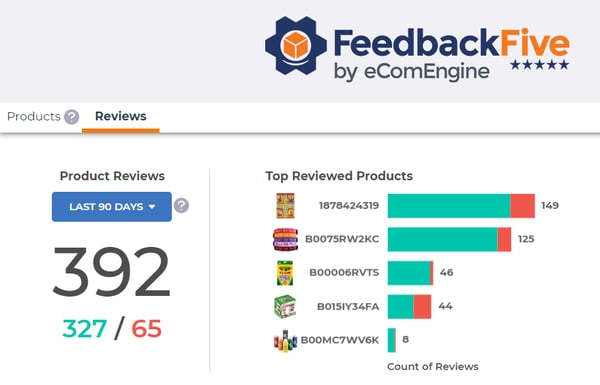 Leveraging Amazon review software, such as FeedbackFive, can be a more efficient way to stay on top of product reviews. The Amazon review tracker continuously monitors all of your ASINs and notifies you (via text message and/or email) within moments of an issue that requires your attention.
Leveraging Amazon review software, such as FeedbackFive, can be a more efficient way to stay on top of product reviews. The Amazon review tracker continuously monitors all of your ASINs and notifies you (via text message and/or email) within moments of an issue that requires your attention.
You can also see the impact of your review requests, including a historical view of one-tap ratings and written reviews received. Detailed campaign analytics offer important insights for your Amazon review strategy.
Vendor Central does not support review requests. However, vendors can monitor and receive alerts for Amazon reviews. This review data offers important insight into how products are performing on Amazon, improvements that could be made, and more.

It is important that you regularly check the reviews that customers are writing about your products. As a seller you should be listening to what the customer is saying, as it could help you improve your products and service.Carina McLeod
Unlike Amazon feedback, which can be downloaded from Seller Central, review data is not easily accessible to merchants who are not brand registered. Some sellers maintain review data in documents or spreadsheets (such as our free template for Microsoft Excel). Although this approach is certainly better than nothing, spreadsheets can be prone to error and costly to maintain. They also divert your attention from growth-oriented activities like product sourcing, private labeling, bundling, and advertising.
A more scalable approach leverages Amazon product review software, such as our FeedbackFive tool. Review software eliminates the time-consuming tasks involved with ASIN monitoring, delivering in-depth data analytics that are kept current in near real-time. Colorful charts and graphs bring your review data to life, making it easier to make informed decisions about buyer preferences and satisfaction trends on Amazon. You can even export Amazon reviews to CSV from FeedbackFive for analysis outside the tool.
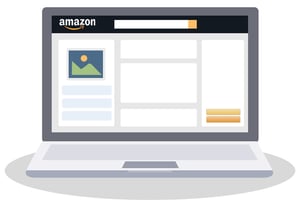 Amazon allows customers to change or remove their reviews at any time. However, sellers cannot ask buyers to edit or remove their reviews. If a review violates Amazon's community guidelines, Amazon may remove the review. Check this Amazon review removal policy to see if your review could qualify for removal.
Amazon allows customers to change or remove their reviews at any time. However, sellers cannot ask buyers to edit or remove their reviews. If a review violates Amazon's community guidelines, Amazon may remove the review. Check this Amazon review removal policy to see if your review could qualify for removal.
So, what can you do about an unwarranted negative review? If the review was abusive or violated Community Guidelines, report it to Amazon. Otherwise, attempt to resolve the buyer's issue with your product, but be aware that it may not lead to an updated review. Buyers do not have to remove or change their reviews even when the problem is resolved. Never attempt to influence a buyer to change their review.

Hey, negative reviews happen sometimes. Here's how to handle them.
Negative reviews can really hurt. It's hard not to take them personally, but try to view them as a learning experience. When you receive the inevitable negative rating, you can send a message through the Customer Reviews page in Brand Registry to ask for more information about what went wrong or offer a refund/replacement item. Unfortunately, this feature is currently only available to brand registered sellers. There is no other Amazon compliant way to reach out to a customer to attempt to resolve a negative experience. If the customer contacts you, be sure to respond in a professional manner and attempt to resolve the issue if you can.
Amazon does not allow buyers to post "abusive or inappropriate" language. Buyers are also not allowed to share "personal information about a transaction partner." If you receive an abusive review that violates Amazon's Community Guidelines, you can report it to Amazon for potential removal.
Negative reviews can be useful for your Amazon business. Look for common concerns and work with your supplier to resolve them. Negative reviews may signal the end of a product life cycle or highlight opportunities to innovate.
You want positive reviews, but that doesn't mean you must only have 5-star ratings. In fact, while positive reviews are obviously a boon to your business, a product review rating that is too close to perfect might scare some buyers away as it may look too fake. The occasional negative review can actually help your business and humanize you to buyers.
Sometimes negative reviews can mean that it's time to revisit your product description. Are you experiencing negative ratings for failure to meet buyer expectations? Revise your listing to ensure that all variations and dimensions are described effectively. Consider including FAQs or updating your product images to answer common questions. Check your recent reviews to see if there are potential keywords you should add to your listing based on what customers are saying about your product.
The occasional negative review is bound to pop up. However, if you regularly receive negative reviews for the same product, it might be time to stop selling it. That's especially true if you've already tried to make improvements to the product and listing. Not every product is a winner. Sometimes it's better to refocus your efforts on a new product.
Reviews that violate Amazon's policies may be eligible for removal. If you have hundreds of negative reviews across your catalog, TraceFuse has the technology to save you time while submitting cases on your behalf. Check out our webinar on How to Handle Negative Reviews to learn more.

Reviews are extremely important as a buyer because this is direct feedback from your consumer. Reviews are critical to your success as an Amazon seller.Gregory Elfrink
You need recent and relevant reviews to keep your listings performing well on Amazon. Requesting reviews manually is tedious and time-consuming, so using an automated review request tool such as FeedbackFive is a great way to reclaim your time while continuing to get reviews. FeedbackFive also actively monitors your listings for issues such as search suppression and hijacking. Get started today with a free trial!
14321 Winter Breeze Drive
Suite 121 Midlothian, VA 23113
Call us: 800-757-6840


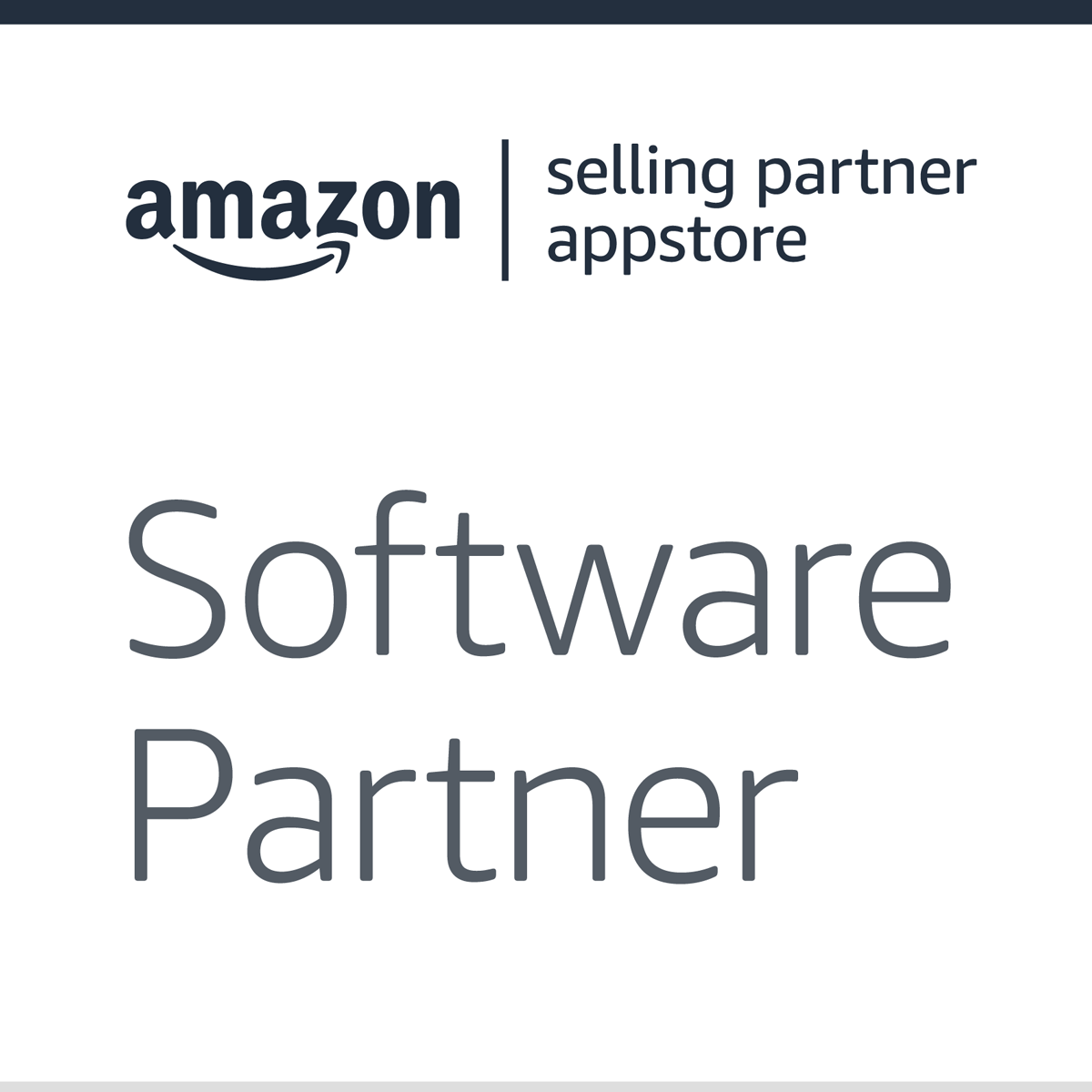


Copyright© 2007-2025 eComEngine, LLC. All Rights Reserved. eComEngine®, FeedbackFive®, RestockPro®, and SellerPulse® are trademarks or registered trademarks of eComEngine, LLC. Amazon's trademark is used under license from Amazon.com, Inc. or its affiliates.